Introduction to Kubernetes Day 2 Operations

What are Day 0, Day 1, and Day 2 operations in SDLC?
The Software Development Life Cycle (SDLC) is a process used to design, develop and test high-quality software applications. It is an iterative process that involves planning, creating, testing, and deploying information systems across hardware and software.
Day 0 - Development
Day 0 is the first stage of the SDLC which focuses on the development process. This includes coming up with ideas for new products or features and designing a plan for how they will be implemented.
Day 1 - Ideation
Day 1 focuses on ideation and coming up with new ideas for products or features. This includes brainstorming sessions with stakeholders to come up with innovative solutions that can help solve customer problems or improve existing products.
Day 2 - Operations & Maintenance
Day 2 focuses on operations and system maintenance tasks which include routines such as monitoring, logging, backup and recovery, security management, capacity planning, performance tuning, and disaster recovery planning.
This stage also involves making changes or updates to existing software in order to keep it running smoothly and efficiently over time.
Day 2 operations specifically refer to the tasks required for maintaining an application or system once it has been deployed and is live in production environments.
What are Day 2 Operations in Kubernetes?
In Kubernetes, Day 2 operations refer to the tasks required to manage and maintain a Kubernetes cluster after it has been initially set up.
These operations include:
- Monitoring cluster health and performance, including node and pod health, resource usage, and network traffic
- Scaling the Kubernetes cluster by adding or removing nodes, adjusting pod replicas, and configuring autoscaling policies
- Responding to incidents and user requests for support, including troubleshooting issues with Kubernetes resources, containers, and applications
- Updating and managing Kubernetes applications, including rolling out new versions, managing deployment strategies, and configuring secrets and configuration data
- Troubleshooting system issues and debugging application errors, including analyzing logs and metrics and identifying root causes of failures
- Managing storage volumes and persistent data, including configuring storage classes, setting up backups and disaster recovery plans, and monitoring data usage and performance
- Ensuring security compliance, including implementing RBAC policies, configuring network policies, and scanning containers for vulnerabilities and compliance violations
- Performing backups and disaster recovery procedures, including configuring backup policies, managing backup data and retention, and testing restore procedures to ensure data integrity and availability.
Day 2 operations are essential because they are critical to ensuring the long-term success and stability of a Kubernetes cluster. Without proper management and maintenance, the cluster may become unstable or vulnerable to incidents, security breaches, or other issues. Proper Day 2 operations can help ensure that the cluster remains reliable, scalable, and secure, and can help organizations avoid costly downtime or other disruptions that could negatively impact their operations.
Challenges of Day 2 Operations
Challenge 1: Managing Upgrades
Upgrading Kubernetes can be a complex and challenging process, as it can affect many components of the system and introduce unforeseen issues. Some potential issues include incompatibilities with existing applications, breaking changes, improper configuration, loss of data, or degraded performance.
Solution: In order to manage upgrades effectively, it's important to perform thorough testing before making any changes. This includes testing new versions in a staging environment and monitoring the performance of the cluster after the upgrade. It's also recommended to backup data and configuration files before performing upgrades and having a rollback plan ready in case of issues.
Challenge 2: Ensuring Robust Security Protocols
A secure Kubernetes infrastructure is critical to prevent unauthorized access or data breaches. Kubernetes includes several security features such as role-based access control (RBAC), network policies, and pod security policies, but configuring them properly can be challenging.
Solution: Review the Kubernetes Security Best Practices and adhere to the guidelines carefully. Use RBAC to restrict permissions, implement network policies to control ingress and egress traffic, and set up pod security policies to enforce access control.
Challenge 3: Scaling Successfully
Kubernetes clusters offer scalability and elasticity for applications, but proper load balancing and auto-scaling are critical to ensure that resources are available as needed. Overprovisioning can lead to unnecessary expenses, while underprovisioning can cause bottlenecks and performance issues.
Solution: Use automatic scaling and load balancing features to accommodate traffic surges and scale down during periods of low activity to save expenses. Implement cluster autoscaling to automatically adjust the number of nodes. Kubernetes has many different approaches to load-balancing, both built-in and external.
Challenge 4: Implementing Effective Monitoring and Backup Systems
Kubernetes includes monitoring and backup systems, but configuring them properly can be a challenge. Monitoring helps identify problems quickly, while backups ensure that important data and configuration information can be restored in case of catastrophic failures.
Solution: Implementing an end-to-end monitoring solution is important to catch performance issues or configurations before they become severe problems. Kubernetes integrates with many monitoring software packages, so consider monitoring tools that can be integrated with Kubernetes native tools. Create backup and restore policies and periodically test the backups to ensure they are working.
Challenge 5: Managing Resources Effectively
Effective resource management ensures that the Kubernetes cluster runs optimally and without issues. Kubernetes includes features such as resource quotas, but it can be tricky to configure them properly.
Solution: Setting up resource boundaries is important to achieving optimized resource management and cost savings. Limit the number of resources used by individual namespaces and enforce quotas to eliminate the risk of a single pod taking all available resources.
Challenge 6: Resolving Configuration Issues
A complex infrastructure like Kubernetes can be challenging to configure correctly and to diagnose issues when problems arise, such as network connectivity failures or container startup failures.
Solution: Review the available configuration options in the documentation of every component of your Kubernetes infrastructure. Use Kubectl to diagnose issues in detail and use Kubernetes native logging tools for the visibility you need.
Challenge 7: Managing Persistent Storage
Persistent storage is an essential component of many applications, and managing storage volumes in Kubernetes can be complex. Storage volumes must be provisioned, bound to pods, and managed throughout the application lifecycle.
Solution: Kubernetes provides several mechanisms for managing persistent storage, such as Persistent Volume Claims and Storage Classes. By using these features, organizations can ensure that applications have access to persistent storage that is properly configured and managed.
Challenge 8: Ensuring High Availability
High availability is critical to ensure that applications and workloads remain accessible, even in the presence of hardware failures, network outages, or other disruptions. Achieving high availability in Kubernetes requires careful planning and configuration.
Solution: Set up nodes in different zones, regions, or even cloud providers to prevent single points of failure. Use replicas to ensure that workloads can continue running even in the event of a node failure. Use liveness and readiness probes to detect and respond to application failures.
Challenge 9: Managing Configuration Files
Configuration files are essential to setting up Kubernetes environments and managing workloads, but changes to configuration files can cause confusion and errors, leading to serious problems and outages.
Solution: Store configuration files in version control repositories like Git or versioned object storage like AWS S3 or Google Cloud Storage. Use standard formats like YAML or JSON for readability and consistency, and use configuration management tools like Kustomize or Helm to manage large or complex configuration files.
Challenge 10: Integrating New Services and Technologies
Kubernetes supports a wide range of plugins and integrations with other technologies, which can add to its complexity and make it difficult for teams to keep up with new technologies.
Solution: Prioritize technologies and services that align with business goals and the needs of the users. Evaluate new technologies before adding them to the Kubernetes infrastructure to ensure compatibility and stability. Use an automated and standard approach for configuring and integrating new technologies, increasing speed and reducing the risk of human errors.
Overall, organizations face a variety of challenges when it comes to Day 2 Kubernetes operations. By implementing solutions such as thorough testing and monitoring, adhering to security best practices, using proper scaling techniques, implementing effective backups and disaster recovery policies, and using available tools and logging resources to diagnose configuration issues promptly, organizations can build reliable and efficient Kubernetes systems.


Comments ()